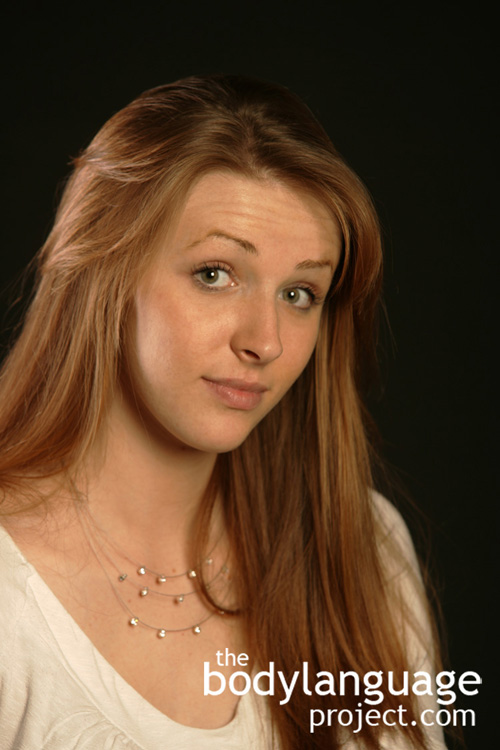Body Language of The Eyebrow Cock
Synonym(s): Raising One Eyebrow, Single Eyebrow Raise.
Description: A mixed eyebrow movement where one eyebrow is raised while the other is lowered.
In One Sentence: The eyebrow cock is a signal that a person is suspicious.
How To Use it: Use the eyebrow cock to tell others that you are in general disbelief with respect to an action performed, or a comment made.
Context: General.
Verbal Translation: “I’m suspicious of your motives so my eyes will show surprise by raising on one side and anger by lowering on the other.”
Variant: See Eyebrow Flash, Eyebrow Hold, Eyebrow Lowering, Eyebrow Raise, Eyebrows Knit or Oblique Eyebrows Of Grief.
Cue In Action: She stood up and vehemently denied being the one who stole the doughnut despite overwhelming evidence. Her mom looked at her, turned her head to the side, raised one eyebrow and lowered the other, then compressed her lips. She was showing suspicion nonverbally.
Meaning and/or Motivation: It represents both aggression and fear at the same time due to the division of high and low, and when mixed, indicates suspicion or skepticism.
Cue Cluster: The head is often tilted to the side when representing skepticism. The eyes will squint when showing aggression and the lips will purse.
Body Language Category: Amplifier, Eye Language, Hostile body language, Negative body language, Suspicious body language or suspicion.
Resources:
Grammer, Karl ; Schiefenhövel, Wulf ; Schleidt, Margret ; Lorenz, Beatrice ; Eibl eibesfeldt, Irenäus. Patterns on the Face: The Eyebrow Flash in Crosscultural Comparison. Ethology. 1988. 77(4): 279-299.
Hall, Judith ; LeBeau, Lavonia ; Reinoso, Jeannette ; Thayer, Frank. Status, Gender, and Nonverbal Behavior in Candid and Posed Photographs: A Study of Conversations Between University Employees. Sex Roles. 2001 44(11): 677-692.
Martin, David John. 1997. Slaughtering a sacred cow: The eyebrow flash is not a universal social greeting. Dissertation Abstracts International: Section B: The Sciences and Engineering 58(5-B): 2751.
Moore, Monicam. Human Nonverbal Courtship Behavior—A Brief Historical Review. Journal of Sex Research. 2010 47(2-3): 171-180.
Moore, Monica. Courtship Signaling and Adolescents: Girls Just Wanna Have Fun. Journal of Sex Research. 1995. 32(4): 319-328.
http://bodylanguageproject.com/articles/girls-just-want-to-have-fun-the-origins-of-courtship-cues-in-girls-and-women/
Navarro, Joe. 2008. What Every BODY is Saying: An Ex-FBI Agent’s Guide to Speed-Reading People. William Morrow Paperbacks.
Schmidt, K. L., Bhattacharya, S., & Denlinger, R. (2009). Comparison of deliberate and spontaneous facial movement in smiles and eyebrow raises. Journal of Nonverbal Behavior, 33, 35–45.
Shichuan Du; Yong Tao and Aleix M. Martinez. Compound facial expressions of emotion. Published online before print on March 31, 2014. DOI10.1073/pnas.1322355111
http://bodylanguageproject.com/articles/in-fact-there-are-more-than-21-facial-expressions/
Teixeira Fiquer, Juliana; Paulo Sérgio Boggio and Clarice Gorenstein. Talking Bodies: Nonverbal Behavior in the Assessment of Depression Severity. Journal of Affective Disorders. 2013. 150: 1114-1119.
http://bodylanguageproject.com/articles/using-nonverbal-behaviour-to-assess-depression-severity/
Watt, Roger ; Craven, Ben ; Quinn, Sandra. A role for eyebrows in regulating the visibility of eye gaze direction. The Quarterly Journal of Experimental Psychology. 2007. 60(9): 1169-1177.
Wheldall, Kevin ; Mittler, Peter. Eyebrow-raising, eye widening and visual search nursery school children. Journal of Child Psychology and Psychiatry. 1976. 17(1): 57-62.

